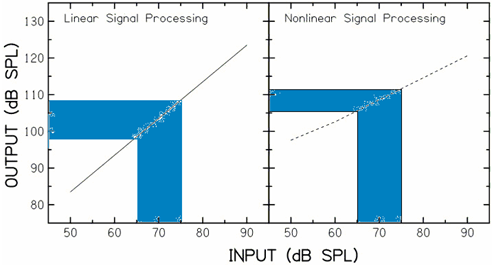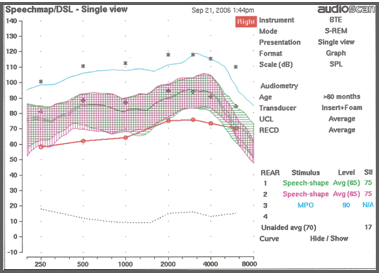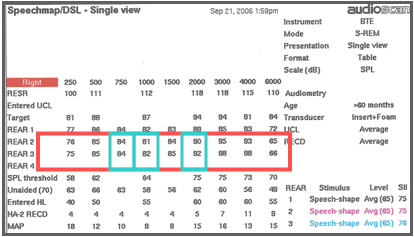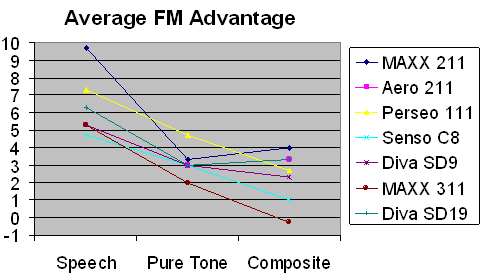Advances in hearing instrument and frequency modulated (FM) assistive technology have provided audiologists with a variety of options to meeting client/patient needs when fitting these devices. However, technological advances require changes in the way we fit FM systems and monitor their performance. This paper will discuss electroacoustic evaluation of FM systems and recent changes in recommended evaluation procedures.
There are three main goals that should be considered when fitting FM systems:
- Audibility of the person wearing the FM transmitter/microphone
- Audibility of self
- Audibility of others at a variety of distances
For many years, audiologists often were forced to prioritize the three mentioned FM goals, knowing that they could not meet them all. The prominent use of linear hearing instruments meant that the voices of speakers not wearing the FM microphone might not be audible, especially if the speaker was talking softly or from a distance. By coupling advanced-technology hearing instruments with universal ear-level FM receivers that allow selection of a variety of FM-level settings, FM systems can be set to maximize different listening environments and achieve all FM goals. The reader is referred to Lewis and Eiten (2004a) for a discussion of listening goals and possible FM settings to achieve those goals (a CD provided with the text includes recordings of FM systems set for different listening situations). Although the desired FM-level setting may vary across listening environments, current FM/hearing-instrument technology does not allow the programming to be adjusted for each situation. Lewis and Eiten (2004a) concluded that a +10 FM level setting was a good compromise for achieving the three priorities listed above, when FM systems are coupled to advanced-technology hearing instruments. The remainder of this paper will focus on electroacoustic approaches to verify FM fitting priorities.
Electroacoustic Approaches
Over time, various approaches for the fitting and verification of FM performance have been developed, with varying degrees of success. ASHA's 1994 "Guidelines for Fitting and Monitoring FM Systems" recommended that output of the FM system with an 80 dB SPL input be matched to output of the hearing instrument/environmental microphone with a 65 dB SPL input. Specifications for input levels to the respective microphones was based on the estimation of sound pressure level when the FM transmitter mic was six to eight inches from the speaker's mouth, as opposed to the increased distance of a speaker's voice to reach the hearing aid microphone. The assumption behind this method is that if the hearing instrument has been set appropriately for an individual's hearing loss, the same output characteristics would be appropriate for the FM system. This has often been called the equal output approach. While an equal output approach would be appropriate when the FM transmitter and hearing instrument microphones are not active at the same time (e.g., FM-only), equating outputs when both microphones are active eliminates the signal-to-noise ratio advantage the listener would receive by way of the FM system. In this case, the FM fitting would not achieve the desired goals. At our facility we attempted to overcome the difficulties inherent in an equal-output approach by implementing a "bracketing" procedure. Using the fitting software we set the FM output 5 dB above our original hearing-instrument target and the hearing instrument/environmental microphone output 5 dB below the target. In this way we attempted to give priority to the FM signal without significantly compromising the audibility of the user's own voice or the voices of others.
ASHA's 2002 "Guidelines for Fitting and Monitoring FM Systems" attempted to address the need for an FM advantage when both the FM and hearing instrument microphones are active simultaneously. This has often been called the FM advantage approach. Steps to obtain this advantage are outlined as follows:
- Measure hearing-instrument output with a 65 dB SPL 1000 Hz pure tone
- Measure FM output with a 65 dB SPL 1000 Hz pure tone and adjust to match output of the hearing instrument
- Measure FM output with an 80 dB SPL input and look for a 10 dB increase
- After the initial adjustment, run full frequency response curves using a speech-weighted input to confirm that the desired FM advantage is maintained for octave frequencies from 500 to 2000 Hz
Therefore, the FM advantage actually experienced by the user corresponds to the relative strengths of both signals at the input of the hearing instrument" (Platz, 2004). In other words, in actual use the stronger (FM) signal determines the compression for both inputs (HI and FM).

Figure 1. Input/output functions for linear and nonlinear signal processing hearing instruments. Note. adapted from Platz (2004, 2006).
The sequential testing method, therefore, creates a dilemma when trying to assess FM-system performance. In actual use, the inputs to the FM and hearing instrument microphones are simultaneous. However, we have no clinically-available methods for measuring simultaneous inputs. Thus, the question is, can we use sequential measures to estimate simultaneous performance? The answer is yes, if the FM transmitter and hearing instrument microphone signals are manipulated by the same amount of compression (i.e., inputs are of the same magnitude). In other words, estimating simultaneous performance could be possible if we test both the FM and hearing instrument with the same input level and at a level below the kneepoint of the FM system.
An FM Offset Procedure, also termed the Phonak FM Offset Procedure or POP (Lewis & Eiten, 2004b; Platz, 2006; Phonak, 2006), has been developed to address the need to test the FM and hearing instrument sequentially. It can be used, as described below, for any FM system that can be set to provide a +10 dB FM advantage. Per Platz (2006), FM offset is influenced by hearing-instrument audio input sensitivity, microphone sensitivity, or microphone impedance. It is not influenced by hearing-instrument signal processing scheme or volume control. With adjustable FM receivers, FM offset can be compensated for by adjusting the gain of the FM receiver.
Basic FM Offset Procedure for Electroacoustic Evaluation of FM Systems
- It is assumed that the hearing instrument has been set appropriately for a given individual's degree and configuration of hearing loss.
- Turn OFF any automatic feedback control and/or noise reduction (if possible) on the hearing instrument.
- Attach the FM receiver to the hearing instrument.
- Program the FM receiver for a +10 FM advantage.
- Set the FM system to the FM+HI (or FM+Mic) position.
- Place the hearing instrument in the test box .
- With the FM microphone outside the test box on mute (or in a quiet room), evaluate the output of the hearing instrument with a 65 dB SPL input signal (speech is the preferred signal).
- Place the FM transmitter microphone in the test box.
- With the hearing instrument outside the test box, but still attached to the 2-cc coupler, (in a quiet room--remember, its microphone is active), evaluate the output of the FM coupled to the hearing instrument with the same 65 dB SPL input signal.
- Compare the two output responses. Any difference is the FM offset (Figure 2).

Figure 2. Verification of input to the hearing instrument microphone (green horizontal hatched area) and FM system microphone (pink vertical hatched area) with 65 dB SPL speech inputs, using Audioscan Verifit™ (version 2.4.27). - Evaluate the offset at discrete frequencies (e.g. 750, 1000, and 2000 Hz)**, as shown in Figure 3.

Figure 3. Table view of the above FM offset verification using Audioscan Verifit™ (version 2.4.27). REAR 2 is from the hearing instrument measurement, and REAR 3 is from the FM system measurement. - Subtract the hearing-instrument average from the FM average. If the difference is>+2 dB, change the FM setting as appropriate and re-evaluate.

In the example above, the average FM offset is 1 dB. Because this is less than +2 dB, no changes in FM setting are needed.
How do we know the FM Offset Procedure works?
When we first began using this procedure, we did so a bit reluctantly because we had no way, clinically, of testing whether the procedure worked as it should. That is, when adjusting the FM and hearing instrument for transparency with a 65 dB SPL input signal, how could we know that a +10 dB FM advantage programmed into the receiver would occur when there was a higher input into the FM microphone? Rainer Platz at Phonak addressed this concern using laboratory measures which allowed simultaneous and sequential inputs to both the FM and hearing instrument microphones. Results of his measurements are available for download from the Phonak website (Platz, 2006). To summarize, his results showed that, for the Phonak programmable receivers, when the FM level was set to +10 dB, the difference in output for simultaneous inputs to the FM (80 dB SPL) and hearing instrument (65 dB SPL) microphones, once any FM offset had been accounted for, was 10 dB. It should be noted that similar testing has not been completed with FM systems from other manufacturers.
Do you still think you want to use the ASHA (2002) FM advantage procedure?
If you used the ASHA (2002) protocol as much as we did, you may be a little reluctant to change to a new procedure. Perhaps you are still thinking that continuing to use the older procedure will not have a significant effect on your fitting results. Figure 4 illustrates the average FM advantage measured the using the ASHA 2002 procedures After the system had already been set for a +10 dB advantage using the offset procedure. The same seven hearing instruments were evaluated electroacoustically using speech, constant-level pure tones, and composite-weighted noise inputs. As this figure shows, only one hearing instrument for one of the input signals demonstrated an FM advantage close to the programmed FM advantage. If the ASHA procedures had been used to set any of these instruments, the audiologist would have inappropriately adjusted the FM level setting by anywhere from +3 to +10 dB. The result would have been FM advantage settings of +13 to +20, rather than the +10 value the audiologist thought was being provided. Setting the FM level too high can result in complaints of a distorted FM signal or the inability of the user to hear themselves or other talkers when the FM and hearing instrument microphones are both active.

Figure 4. Average FM advantage (750, 1000, 2000 Hz) measured using a 65 dB SPL input to the hearing instrument microphone and 80 dB SPL input to the FM microphone. The seven hearing instruments were coupled to Phonak MLx-S receivers and had already been adjusted for +10 FM advantage using the FM offset procedure.
Should we give up the ASHA 2002 guidelines completely?
While the electroacoustic measurements recommended by the ASHA 2002 guidelines are not appropriate for FM systems coupled to nonlinear hearing instruments, there are a number of recommendations from those guidelines that can be useful for audiologists fitting FM systems:
- It is advisable to assess performance with a speech-weighted input, using the same type of signal for both local mic and FM system. Because electroacoustic responses from hearing instruments and FM systems may differ for different input stimuli, it is important to use the same stimuli for all measurements.
- 2-cc Coupler Assessment procedure includes ANSI standards (hearing instrument), as well as a variety of output measures in SPL. Completing measures according to ANSI standards allows for a comparison to manufacturer specifications for hearing instruments. Currently, there are no published ANSI standards for hearing assistance technology, including FM systems. Comparisons with manufacturer specifications are helpful but do not provide information about how the system will function as set for an individual user.
- Functional gain/aided soundfield thresholds are NOT recommended as verification procedures. While these measures provide information about how the system responds to soft sounds, they do not evaluate the amplification received by the user at input levels comparable to those at FM/hearing instrument microphones. As such, they do not give an accurate picture of the audibility of speech at conversational levels. In addition, functional gain measures do not provide information about maximum output.
- Speech perception measures with FM are recommended, with priority given to testing in noise under the hearing instrument plus FM condition. Speech perception measures performed in a clinical setting can provide a first-step verification of performance in quiet and noise, both for the hearing instrument alone and the hearing instrument coupled to the FM system. Readers are referred to the ASHA 2002 FM Guidelines for further discussion of clinical speech perception measures using an FM system.
- The FM system should increase the level of the perceived speech, in the listener's ear, by approximately 10 dB relative to the signal at the hearing instrument microphone. While the guidelines did specify some exceptions to this guideline, the general goal was to maintain an FM advantage of the voice of the person wearing the FM transmitter microphone.
Summary
Advances in FM technology provide audiologists with the ability to address a variety of FM-system fitting goals. Audibility of the target talker, as well as audibility of self and others in the surrounding environment are important issues that FM systems were originally designed to address. Current programmable not only better meet these goals, but FM receivers allow added flexibility to obtain the most desirable FM advantage for the listener. Consequently, these advances require new protocols for fitting and verification of FM system performance. As a clinically feasible simultaneous verification protocol has yet to be established, the FM Offset Procedure (also called the Phonak FM Offset Procedure or POP) is currently recommended as a valid sequential procedure to establish an appropriate FM advantage for advanced-technology FM systems coupled to nonlinear hearing instruments. Additional research to address even more recent advances in FM system technology (such as wide dynamic range compression characteristics) is also being conducted to ensure appropriate verification procedures are available to professionals who fit these systems.
Footnotes
* 75 dB SPL is used here instead of the 80-85 dB SPL expected at the FM transmitter microphone to represent the compression kneepoint in an FM transmitter.
** Repeated measures of FM offset performed at our facility showed stable, repeatable responses between approximately 750 and 3000 Hz.
References
American Speech-Language-Hearing Association. (1994). Guidelines for fitting and monitoring FM systems. ASHA, 36(Suppl.):1-9.
American Speech-Language-Hearing Association. (2002). Guidelines for fitting and monitoring FM systems. ASHA Desk Reference.
Lewis, D.E. & Eiten, L.E. (2004a). Assessment of advanced hearing instrument and FM technology. In D.A. Fabry and C. DeConde Johnson (Eds.), ACCESS: Achieving Clear Communication Employing Sound Solutions-2003. Proceedings of the First International FM Conference. (pp. 167-174). Phonak AG.
Lewis, D. & Eiten, L. (2004b). "Proposed protocol for setting FM-advantage levels with MLx-S FM receivers". Poster Presentation. A Sound Foundation Through Early Amplification Conference, Chicago, IL. Available on CD included with A Sound Foundation Through Early Amplification 2004. Proceedings of the Third International Conference. R.C. Seewald & J.M Bamford (Eds.). Phonak AG.
Phonak. (2006). Phonak FM offset protocol. Available for download from www.phonak.com/professional/eschooldesk/professional-eschooldesk-reading.htm
Platz, R. (2004). SNR advantage, FM advantage, and FM fitting. In D.A. Fabry and C. DeConde Johnson (Eds.), ACCESS: Achieving Clear Communication Employing Sound Solutions-2003. Proceedings of the First International FM Conference. (pp. 147-154.). Phonak AG.
Platz, R. (2006). New insights and developments in verification of FM systems. Available for download from www.phonak.com/professional/eschooldesk/professional-eschooldesk-reading.htm


